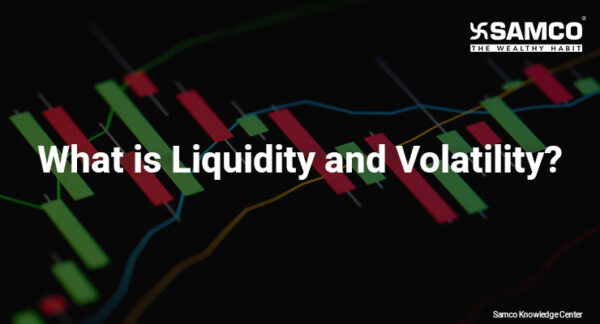What is Liquidity?
Liquidity describes how quickly an asset can be bought and sold and converted into cash. In simple terms, a highly liquid asset can be easily bought and sold in the market. Whereas if there are few market participants who trade infrequently, it is said to be a low liquid asset. Example: Mr Ram bought 1,000 shares of ABC Ltd. for Rs 100 and sold it at Rs 105 within 30 minutes. In this case, the shares of ABC limited are highly liquid.What is Volatility?
Volatility is a rate at which the price of a security increases or decreases for a given set of returns.- If the price of a share fluctuates rapidly in a short time span, it is termed to be a highly volatile share.
- If the price of a share fluctuates slowly in a longer time span, it is termed to be a low volatile share.

Why is market liquidity and volatility Important?
Importance of market liquidity-
- Market Liquidity primarily impacts how quickly you can open and close a position in a stock.
- It is generally less risky, as there is always another investor who is willing to take the other side of the position.
- Highly liquid stocks attract speculators and investors to the market.
- A liquid share has a narrow spread, while in an illiquid market has a wider spread.
-
- Traders usually analyse the volatility index to determine the outlook of investors on a particular share.
- The more volatile a stock is the bigger price moves, which provides greater opportunities for profits and vice versa.
- Volatility assesses the performance of a stock.
How to use liquidity and volatility in markets?
- For Intraday trading:
- For short term traders, the view is to quickly grab profit from lesser market movements. If a share has low volatility, the movements are smaller and so are the opportunities you get to cover the trade. Hence, you need to look for shares which have high liquidity and volatility.
- For Option trading:
- While trading in options, a trader could buy a call option and a put option with the same strike price and expiration date. If the underlying instrument experiences a large price-move, either the put or call option will become in-the-money and give returns.
Watch this video to learn how to pick F&O Stocks For Intraday Trading
- For currency trading:
- Some of the currency pairs are highly liquid and volatile. Major currency pairs tend to be more stable than emerging market currency pairs like USD/INR. If a currency is less volatile, you can look to use support and resistance levels and set your stop loss.
Relationship between liquidity and volatility
'Volatility' is related to multiple factors and 'liquidity' is one amongst them. In the share market, 'Volatility' of a share refers to plenty of buyers and sellers available whenever you want to buy or sell. Whereas, 'Liquidity' helps to keep a small difference between the bid price and the ask price. Liquidity as a single factor, may not be able to reduce the volatility of a stock, but lack of liquidity can cause wild volatility.Important tips for beginners:
When you are trading in the stock market, liquidity and volatility need to be considered before a trade is placed.- If there is volatility in the market, but there are more buyers than sellers, then it can become difficult to close the position.
- Another way to manage liquidity and volatility risk is to use stop-loss as it ensures your position is closed automatically when the target price is triggered.
- Market positions are not necessarily always volatile, it depends on a variety of factors such as the volume of traders, the time of trading, etc.
- If you are trading in 'out of market' hours, you might find that there are fewer participants and the volume and liquidity are much lower.
Which markets are most liquid and volatile?
- FOREX market
- Commodity market
- Crude oil
- Precious metals
- Sugar



 Easy & quick
Easy & quick
Leave A Comment?